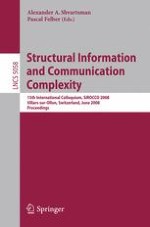The Colloquium on Structure, Information, Communication, and Complexity (SIROCCO) is an annual research meeting focused on the relationship between information and e?ciency in decentralized (distributed, parallel, and network) computing.Thisyear,SIROCCOcelebratedits15thanniversary.Overtheyears, the colloquium has become a widely recognized forum bringing together - searchers interested in the fundamental principles underlying the interplay - tween local structural knowledge and global communication and computation complexity. SIROCCO covers topics such as distributed algorithms, compact data structures, information dissemination, informative labeling schemes, c- binatorial optimization, and others, with potential applications to large-scale distributed systems including global computing platforms, peer-to-peer systems andapplications,socialnetworks,wirelessnetworks,andnetworkprotocols(such as routing, broadcasting, localization). SIROCCO 2008 was held in Villars-sur- Ollon, in the Swiss Alps, June 17–20, 2008. There were 52 contributions submitted to SIROCCO 2008. All papers - derwent a thorough refereeing process, where each submission was reviewed by at least 3, and on average 3.4, Program Committee members. After in-depth discussions, the Program Committee selected 22 high-quality contributions for presentation at the colloquium and publication in this volume. We thank the authors of all the submitted papers, the Program Committee members, and the external reviewers. Without their dedication, we could not have prepared a program of such quality. ThereweretwoinvitedspeakersatSIROCCO2008:NicolaSantoro(Carleton University) and Boaz Patt-Shamir (Tel-Aviv University). We express our gratitude to the SIROCCO Steering Committee, and in p- ticulartoPierreFraigniaudforhisenthusiasmandhisinvaluablehelpthroughout the preparation of this event.
